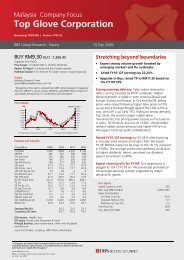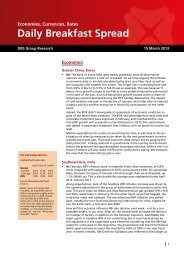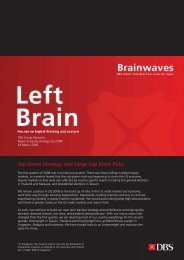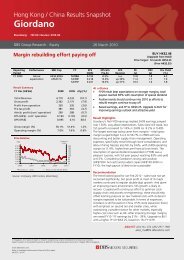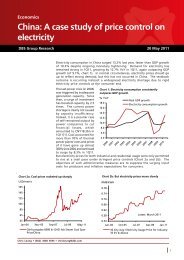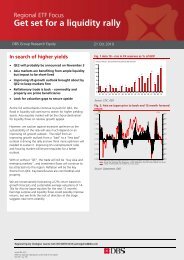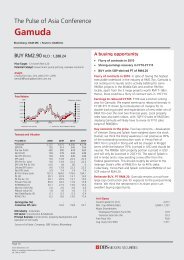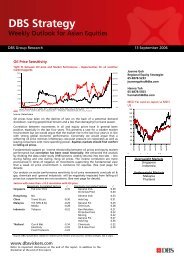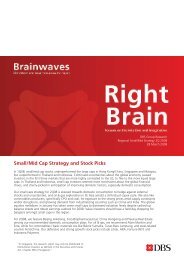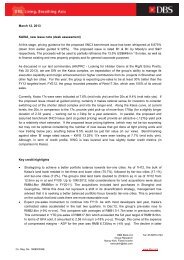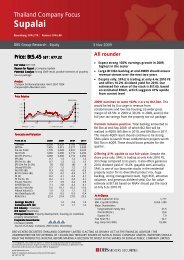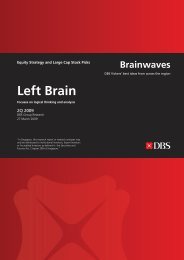Left Brain Right B - the DBS Vickers Securities Equities Research
Left Brain Right B - the DBS Vickers Securities Equities Research
Left Brain Right B - the DBS Vickers Securities Equities Research
Create successful ePaper yourself
Turn your PDF publications into a flip-book with our unique Google optimized e-Paper software.
Regional Equity Strategy 4Q 2009<br />
Strategy Overview: Asia Equity<br />
Korea: Growth vs quality (Ma Tie Ying, matieying@dbs.com, extracted from “Economics – Markets – Strategy,<br />
4Q09” dated 17 September 2009)<br />
• Korea’s growth numbers are undoubtedly strong,<br />
thanks to <strong>the</strong> currency depreciation, fiscal expansion<br />
and monetary easing<br />
• But <strong>the</strong> quality of growth is a concern. Currency<br />
depreciation helped exporters, but also eroded<br />
businesses and consumers’ international purchasing<br />
power. Moreover, <strong>the</strong>re are doubts about whe<strong>the</strong>r<br />
<strong>the</strong> recovery will be sustainined once fiscal and<br />
monetary stimulus fades<br />
• House prices, bank loans and household debt all<br />
experienced fast growth over <strong>the</strong> past several years,<br />
and are rising again. The authorities are worried<br />
about a possible bubble in <strong>the</strong> property market and<br />
problems in <strong>the</strong> banking and household sectors. The<br />
central bank could raise rates as early as 1Q10<br />
The Korean economy grew 11% QoQ saar in 2Q09 after a<br />
0.5% gain in 1Q09. Compared to <strong>the</strong> -18.8% drop in GDP<br />
during <strong>the</strong> outbreak of global financial crisis in 4Q08, <strong>the</strong><br />
recovery so far has amounted to about one half of <strong>the</strong> original<br />
drop in output.<br />
One key growth engine is exports. As of July, custom exports<br />
have increased a cumulative 40% (sa) from <strong>the</strong> bottom in<br />
January, and in real terms, exports have already approached<br />
<strong>the</strong>ir peak levels seen in Sep08 (producers’ shipment index for<br />
exports: 135.0 sa in Jul09, versus 137.1 in Sep08).<br />
Going forward, we expect exports will continue to closely<br />
follow <strong>the</strong> upturn in global demand. Korea has a high exposure<br />
to <strong>the</strong> emerging markets which are leading <strong>the</strong> current global<br />
recovery. As high as 44% of Korea’s exports head to ex-Japan<br />
Asia (including 22% to China), and an additional 15% of<br />
shipments are sold to Latin America and <strong>the</strong> Middle East.<br />
More importantly, <strong>the</strong> price competitiveness of Korean<br />
exporters remains intact as a result of currency weakness.<br />
Although <strong>the</strong> Korean won has streng<strong>the</strong>ned in <strong>the</strong> past several<br />
months in tandem with a globally weaker US dollar, <strong>the</strong><br />
USD/KRW rate remains 20% away from <strong>the</strong> pre-crisis level of<br />
1000. And we forecast only a gradual recovery in <strong>the</strong> won<br />
going forward, similar to <strong>the</strong> trajectory witnessed after <strong>the</strong><br />
1997/98 Asian financial crisis (<strong>DBS</strong>f of USD/KRW: 1190 in end-<br />
09 and 1120 in end-10. The dollar-denominated export prices<br />
currently remain low relative to those of <strong>the</strong> major trade rivals<br />
such as Japan and Taiwan, and such a price advantage is<br />
unlikely to be eliminated soon.<br />
Public investment is ano<strong>the</strong>r source of growth. Public<br />
construction orders have jumped since 1Q09, thanks to <strong>the</strong><br />
government’s decisive and aggressive fiscal actions to<br />
counteract recession. The government has engaged in largescale<br />
spending on civil engineering projects such as roads,<br />
bridges and railways. Machinery orders in <strong>the</strong> public sector<br />
have also soared, boosted by spending in transport and electric<br />
power areas. As <strong>the</strong> newly started infrastructure projects<br />
require certain amount of time to be completed, <strong>the</strong> growth in<br />
public investment would remain robust and underpin growth<br />
in <strong>the</strong> next several months.<br />
Quality is not enough<br />
Korea’s growth figures are undoubtedly strong. But we would<br />
caution that <strong>the</strong> underlying quality of growth is still not great.<br />
The strength in exports is partly due to currency weakness,<br />
which also simultaneously erodes businesses and consumers’<br />
international purchasing power and thus hurts domestic<br />
demand. This is especially true if we consider Korea’s high<br />
reliance on fuel imports and large external debt levels. The<br />
negative effects of KRW weakness are currently masked, as <strong>the</strong><br />
plunge in global fuel prices has significantly lowered<br />
production/living costs for manufacturers and consumers. The<br />
drop in crude oil prices from USD 90/bbl in 2008 to USD 50/bbl<br />
in 1H09 is estimated to help <strong>the</strong> economy to save an amount<br />
equivalent to 4% of GDP on an annual basis. More recently,<br />
<strong>the</strong> stabilization of international financial markets has allowed<br />
Korean banks to roll over or refinance a large portion of <strong>the</strong>ir<br />
external debt. The nation’s short-term external debt has<br />
stopped falling in 2Q09 (USD 147.2bn in June, versus USD<br />
146.1bn in March), and gross external debt has started to<br />
increase once again due to higher long-term borrowings (USD<br />
380.1bn in June, up from USD 369.1bn in March). The<br />
potential negative effects from KRW depreciation should not<br />
be completely dismissed, however, as global commodities<br />
prices have bottomed out, and <strong>the</strong> repayment of external<br />
obligations will still have to be done some day.<br />
Moreover, <strong>the</strong> ongoing recovery largely relies on government<br />
policy support. It remains to be seen if <strong>the</strong> recovery in <strong>the</strong><br />
private sector will be self-sustaining, once <strong>the</strong> government<br />
exits. The rebound in private consumption in 1H09 was<br />
primarily due to a surge in automobile sales, following <strong>the</strong><br />
government’s tax reduction on new car purchases. Retail sales<br />
Page 32<br />
“This report has been re-printed with permission from <strong>DBS</strong> Group <strong>Research</strong><br />
(Regional Equity Strategy) of <strong>DBS</strong> Bank Limited” disclosures on page 37 of this report



